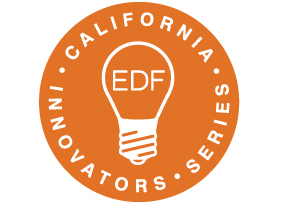 EDF’s Innovator Series profiles companies and people across California with bold solutions to reduce carbon pollution and help the state meet the goals of AB 32. Each addition to the series will profile a different solution, focused on the development of new technologies and ideas.
EDF’s Innovator Series profiles companies and people across California with bold solutions to reduce carbon pollution and help the state meet the goals of AB 32. Each addition to the series will profile a different solution, focused on the development of new technologies and ideas.
Time and again, the people of California have affirmed that pursuing policies to cut climate pollution is critically important for the health of current and future generations. At the same time, history has shown it to be much harder to implement environmental policies if there is a perception that economic health will suffer. The ultimate goal is well-designed public policy that delivers environmental, health and economic benefits together.
In 2006, the state legislature took the environmental and economic paradigm to heart when it passed California’s global warming law, AB 32, creating a fundamental promise that cutting pollution and growing the Golden State’s prosperity will go hand in hand. Today, California business and community leaders are proving that promise to be a reality – and new stories are regularly emerging to show it. Our new AB 32 Innovator Series will work to capture these stories, bringing the companies – and people behind them – into light.
One of the reasons AB 32 has succeeded has been its ability to use market-based programs to cut pollution, allowing for both environmental and economic progress. Economic, government and academic experts have long suggested that well-designed market-based programs are the best tools for achieving pollution reductions because they inspire businesses to identify and apply new and innovative solutions. These solutions are often cheaper and faster at cutting pollution than prior methods, resulting in reduced compliance costs and rapid pollution declines.
For example, in a 2012 paper published in the Proceedings of the National Academy of Science, it said this about a market mechanism used in AB 32 (cap and trade):
“Facilitating innovation in “clean” technologies may be the key to achieving climate change stabilization without dampening economic productivity…CTPs [cap and trade programs] have several attributes that support clean technology innovation.”
For a concrete example of the possibility that innovation provides, think back to the acid rain problem of the 1990’s. Sulfur pollution was spewing from major coal-fired power plants across the U.S., degrading forests, lakes and architectural landmarks at a threatening rate.
When the U.S. Environmental Protection Agency (EPA) adopted a cap-and-trade regulation to help solve the problem, most experts thought installing expensive scrubbers and equipment upgrades across the U.S. was the solution. As a result, power companies across the U.S. predicted runaway costs and facility closures. However, when faced with the opportunity of a market-based solution and its inherent signal to innovate, a simple low-cost solution was developed by these same companies: find lower-sulfur coal and bring it to the power plants by train, rather than using high-sulfur coal located closer by.
Through this simple innovation, compliance costs were 80–90% cheaper than initially estimated.
Unfortunately, most economic models and regulatory implementation scenarios are ill-equipped at predicting innovation because it tends to happen in ways people don’t expect. If it was easy to predict how and when ground-breaking ideas occur, they would have already been applied. As the acid rain example shows, innovation can, and does, take many forms. Accordingly, by documenting the development and implementation of innovative solutions as they emerge, the true potential of policies like AB 32 can be realized. This is the essence of our new California Innovators Series.
In California, AB 32 is helping to develop groundbreaking solutions, proving that the state’s climate policy mission of protecting the economy and the planet can be realized. EDF’s Innovator Series will recognize several of these bold solutions throughout the year in an effort to distinguish the companies positively impacting California’s landscape and inspiring future innovators to come.
Please note, EDF has a standing corporate donation policy and we accept no funding from companies or organizations featured in this series. Furthermore, the EDF California Innovators Series is in no way an official endorsement of the people or organizations featured, or their business models and practices.
 By: Matt Golden, Senior Energy Finance Consultant
By: Matt Golden, Senior Energy Finance Consultant











